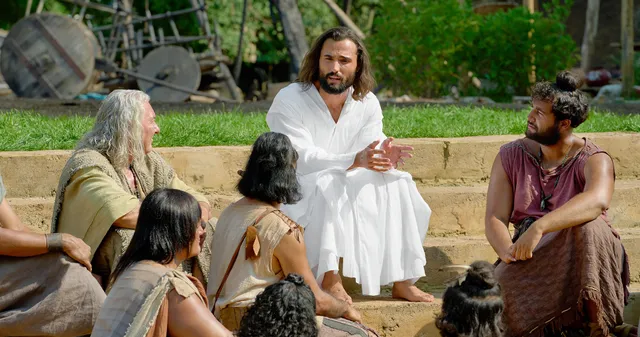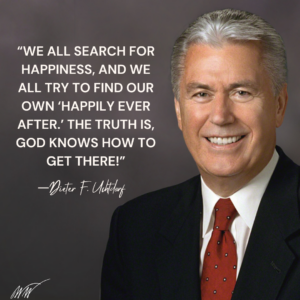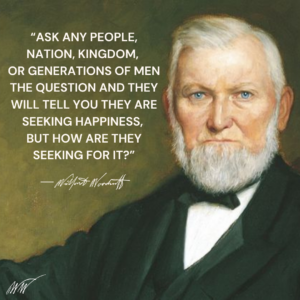
FAIR is a non-profit organization dedicated to providing well-documented answers to criticisms of the doctrine, practice, and history of The Church of Jesus Christ of Latter-day Saints.

“We Rejoice in Christ”
Book of Mormon Chapters: 3 Nephi 27-4 Nephi
Historical Context: Christ establishes His church among the Nephites, teaching them about the importance of taking His name upon them and living according to His gospel. This period leads to centuries of peace and righteousness.
The account of the Three Nephites in 3 Nephi 28 presents a unique situation where three of Christ’s disciples were granted the desire to remain on the earth until His Second Coming. They were “translated,” meaning their bodies were changed so they would not experience death, sickness, or pain, but they would remain in a terrestrial state, fulfilling a divine mission to bring souls to Christ. This doctrine of translation is also seen in other scriptural accounts, such as John the Beloved (see John 21:21–23 and Doctrine and Covenants 7).
The purpose of the Three Nephites’ translation is to minister to the scattered house of Israel, assisting in the gathering of Israel and in the work of salvation. 3 Nephi 28:9 explains that they “shall never endure the pains of death” and “shall bring the souls of men unto [Christ].” They continue their work of ministering among God’s children, but their identities are hidden from the world, and they only reveal themselves according to the Lord’s will.
The idea of translated beings is consistent with God’s power to preserve and protect His servants for His purposes. According to modern revelation and Church teachings, the Three Nephites are still on the earth, carrying out their divine mission. Like John the Beloved, their translated state allows them to perform their ministry in ways not possible for those who are subject to mortality. Their work, though largely unseen, is part of the ongoing effort to prepare the world for the Second Coming of Jesus Christ.
Resource:
Christ’s church in the Book of Mormon mirrors the New Testament structure in many ways, including the presence of apostles (often referred to as “disciples” among the Nephites), ordinances such as baptism and the sacrament, and the core principles of faith in Christ, repentance, and following God’s commandments. However, the Nephite church also adapted to its unique cultural and spiritual circumstances. Here are two examples of these adaptations:
Despite these adaptations, the core principles of Christ’s church, such as faith, repentance, and the ordinances of baptism and the sacrament, remained consistent across both Nephite and New Testament practices. The Nephites, like the early Christians, were centered on the gospel of Jesus Christ, with ordinances administered through priesthood authority.
Resource:
In 3 Nephi 29:1–2, Mormon declares that when the Book of Mormon comes forth, it will be a clear sign that the Lord has begun to gather Israel and fulfill the covenants He made with their forefathers. This is significant because the gathering of Israel has been prophesied throughout scripture as an essential part of God’s work in the latter days. The Book of Mormon, as another testament of Jesus Christ and a witness of God’s dealings with the ancient inhabitants of the Americas, plays a key role in this gathering. Its coming forth invites all people to come unto Christ, and its message is directed specifically to the house of Israel, urging them to recognize their divine heritage and the fulfillment of God’s promises.
The restoration of the gospel through the Book of Mormon also signals the beginning of the great latter-day gathering of scattered Israel, as the knowledge of their identity and God’s covenants with them is once again made available. As members of the Church of Jesus Christ of Latter-day Saints share the message of the Book of Mormon with the world, they participate in this prophesied gathering, which will culminate in the Second Coming of Jesus Christ.
If you have questions on this week’s reading, please email your questions to us here.
There are many principles to find in 3 Nephi 20–26. Some are highlighted in the lesson outline, but you will find others. Let Heavenly Father, through His Spirit, teach you what you need right now.
“Perhaps more people in the world would gain a testimony of Jesus Christ and His Church if they saw more unity among us as members of His Church and as His disciples and authorized servants.” – Elder Uchtdorf
1-12: The 12 Nephite apostles unite in fasting and prayer as they seek to determine what the name of the church should be. Jesus appears to them and clarifies that it should be called by His name, be built upon His gospel and teach His doctrine.
13-22: The Savior explains what is meant by “His gospel.” We are to have faith in His redemptive mission, repent, be baptized, receive the gift of the Holy Ghost and endure to the end. If we do this we will “be lifted up at the last day.” (v.22)
23-27: The Savior emphasizes the importance of keeping a good spiritual record.
28-33: Jesus prepares to leave the Nephites. His “joy is great, even unto fullness” because of their diligence and faithfulness. He shares a few final words of counsel, including the importance of staying on the strait and narrow path, and praying with confidence.
1-12: As Jesus prepares to depart He asks if the disciples have any final requests. Nine ask to return to be with Him upon their deaths. They are promised that they will. Three ask to be allowed to live past their normal life span to be able to continue their ministry. Their request is approved as well. Jesus departs from the Nephites for the last time.
13-23: The transformation of the Three Nephites (the three apostles who will not die) is described. They go forth, teaching powerfully and performing many miracles.
24-33: Mormon shares that he has met the Three Nephites and that they have ministered to him. They will continue their work among Jew and Gentile alike until the “great and coming day” of the Lord.
34-40: Mormon prayed to better understand the nature of the Three Nephites’ bodies. He learned that “there was a change wrought upon their bodies that they might not suffer pain nor sorrow save it were for the sins of the world.” (v.38)
1-9: Mormon testifies that when his record, The Book of Mormon, comes forth, it is a sign that the Lord has begun His work of restoration for the children of Israel. Wo unto those who deny the Christ or His gifts and miracles. Wo unto those who continue to choose wickedness.
1-2: Mormon offers one last plea to the Gentiles, as directed by the Savior, to heed the words of Jesus Christ – to repent, be baptized, filled with the Holy Ghost, and numbered among the covenant children of God.
1-18: Peace, unity, love and prosperity are enjoyed by the Nephites and Lamanites who were taught by the Savior when He visited the Americas. A Zion society is created, and “surely there could not be a happier people among all the people who had been created by the hand of God.” (v. 16)
19-23: Similar happiness and prosperity are enjoyed for the next 90 years, though small divisions are beginning to creep into their society.
24-39: A little over 160 years after the visit of the Savior, pride and materialism begin to fracture the society into various “ites.” Multiple churches are formed, some denying the Christ. Hard hearts and hatred become rampant.
40-49: Two hundred and eight years after the coming of Christ, both the Nephites and Lamanites are choosing iniquity. The Gadianton robbers are enjoying a resurgence of power. Due to the prevailing wickedness, Ammaron finishes his record and hides the plates for safe keeping.
Open in Gospel Library 🡒
…Before I joined The Church of Jesus Christ of Latter-day Saints, I thought I was happy—and I was, to some extent. At 18 years old…
 Recently I attended a priesthood lesson focused on Elder Dieter F. Uchtdorf’s talk “A Higher Joy.” The teacher began the lesson with this question: “What brings you joy and happiness?” As you can imagine, the participants’ answers were interesting and varied. Some of the responses were being with family, doing hard things, repenting, getting married, landing a decent job, and achieving a goal.
Recently I attended a priesthood lesson focused on Elder Dieter F. Uchtdorf’s talk “A Higher Joy.” The teacher began the lesson with this question: “What brings you joy and happiness?” As you can imagine, the participants’ answers were interesting and varied. Some of the responses were being with family, doing hard things, repenting, getting married, landing a decent job, and achieving a goal.
One question to reflect upon is, how are we seeking happiness? One of the promises of Jesus Christ is that as we seek, we can find (Matthew 7:7). Wilford Woodruff had an interesting perspective on this: “Ask any people, nation, kingdom, or generations of men the question and they will tell you they are seeking happiness, but how are they seeking for it?” 
Joseph Smith, while translating the Book of Mormon, recorded 2 Nephi 2:25: “Men are that they might have joy.” He later taught, “Happiness is the object and design of our existence, and will be the end thereof, if we pursue the path that leads to it; and this path is virtue, uprightness, faithfulness, holiness, and keeping all the commandments of God.” The “happiness” entries in the Topical Guide and Index to the Triple Combination say to also see the entries for “blessed,” “cheer,” “delight,” “glad,” “joy,” and others. In other words, many qualities relate to this highly sought-after condition of happiness.
In this week’s Come, Follow Me we get to see firsthand what made the people of Nephi so happy. After the Savior’s tender visit to them, they were changed by His love and immediately showed their willingness to live righteous lives. “Surely there could not be a happier people among all the people who had been created by the hand of God” (4 Nephi 1:15). This is the message of the gospel of Jesus Christ.
Before I joined The Church of Jesus Christ of Latter-day Saints, I thought I was happy—and I was, to some extent. At 18 years old, I started living the commandments better and making and keeping covenants with my Heavenly Father and Jesus Christ. Despite difficulties and challenges, I was internally deeply happy, which continually brought a sincere smile to my face. Compared to before I was baptized, my happiness boosted because of the righteous choices I was striving to make. A peace that surpasses all understanding has made me exclaim, as Ammon, “I cannot say the smallest part I feel” (Alma 26:16; see also Philippians 4:7).
In our quest for finding happiness, let us allow Heavenly Father to guide us. He is there for our happiness and has our best interests at heart. If we live each day with love, grace, and gratitude, we will experience a happiness that surpasses understanding.


FAIR is a non-profit organization dedicated to providing well-documented answers to criticisms of the doctrine, practice, and history of The Church of Jesus Christ of Latter-day Saints.
We are a volunteer organization. We invite you to give back.
Donate Now